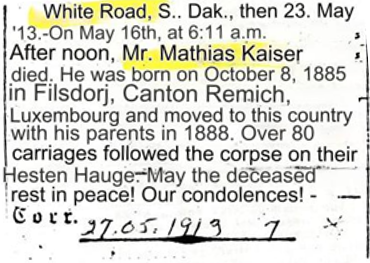|
You never know what tidbit you’ll learn when attending a genealogy online seminar. While the focus of the one I attended was Archon, we also were discussing the old German handwriting plus the Fraktur print that many of us have seen in old birth, marriage and death headers in German documents. Someone shared that they use Google Translate on images of these printed documents. Let’s look. I decided to take a short article about the death of a great uncle in 1913 in South Dakota that was published in the Luxembourg Gazette and written in the Fraktur print. I had the original document translated by a relative and was curious to see how the image view of Google Translate would work. The translation from my relative. Luxemburger Gazette, Dubuque, IA, 27 May 1913, p. 7: White Rock, SD, the 23rd May ‘13 (local newspaper citation date) On the 16th of May, Mr. Mathias Kaiser died at 6:00 in the afternoon. He was born on 8 Oct. 1885 at Filsdorf, Canton Remich, Luxembourg and came to this country with his parents in 1888. Over 80 carriages followed the body on its final journey. May the deceased rest in peace! Our condolences! Courant, Sisseton, SD Here is the translation from Google Translate images. While it wasn’t perfect, it would get you most of the way there on the translation. The town name was Filsdorj rather than Filsdorf. “On its final journey became Hesten Hauge. Otherwise, it was spot on with the translation I had. To use the image translate, go to Google Translate. I left the language at detect language rather than choosing the language. Then above that you can see the choices of Text, Images, Documents, and Websites. As you guessed, choose images. Once you drag your image into the first box, your translated image will appear in the second box. (The first box will be hidden but you can choose to view both by following the instructions on the page.) Once you have your translated image, you can save the image, or you can choose to download the text version of the translation or both. I haven’t tackled complete documents yet but that might be next to explore. I wondered how this would do for a heading on an old Polish Marriage document. So, I’ve included images of the results below. As you can see some columns translated better than others. I suspect the quality of the document image has some influence on this. I hope that you will find it useful to use Google Translate Images to decipher some of those printed records in the Old German Print. I know I will be exploring some more of my old documents to better understand what those printed words meant. Happy translating!
0 Comments
Leave a Reply. |
AuthorWith a lifelong passion for genealogy and history, the author enjoys the opportunity to share genealogy tidbits, inspiring others to research and write their family story. Archives
July 2024
Categories |






 RSS Feed
RSS Feed